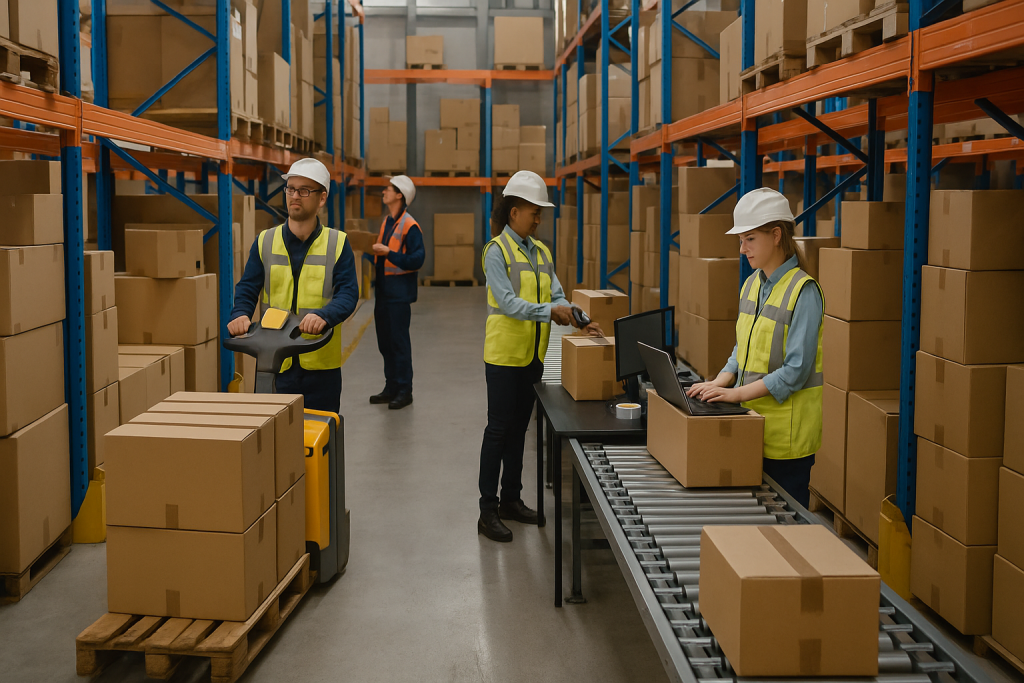By Martin Vassilev / 10 Nov, 2025
Across Canada, a profound shift is underway in how goods are stored, picked, and delivered. The rise of micro-fulfillment centers (MFCs)—compact, automated warehouses positioned closer to end consumers—is transforming the logistics landscape. As Canadian e-commerce continues to surge and customer expectations for same-day delivery soar, traditional fulfillment models are struggling to keep pace. Micro-fulfillment offers a fast, cost-effective, and sustainable alternative, bridging the gap between national distribution centers and the doorstep.
From Toronto’s dense retail hubs to Calgary’s fast-growing logistics corridors, businesses are rethinking how to optimize last-mile delivery. According to data from Innovation, Science and Economic Development Canada (ISED), the logistics and warehousing sector grew by over 22% in the last five years—an evolution driven by automation, AI, and proximity-based fulfillment.
Micro-fulfillment centers are small-scale distribution facilities, typically located within or near urban centers. They’re designed to automate inventory storage and order picking, enabling businesses to fulfill online orders quickly and locally. Unlike massive regional warehouses, MFCs occupy 10,000–50,000 square feet, often repurposing existing retail spaces, parking lots, or smaller industrial units.
The goal? Reduce transportation costs, minimize delivery times, and improve order accuracy—without sacrificing scalability.
For businesses exploring scalable logistics solutions, ByExpress’s guide on choosing the right fulfillment partner provides an excellent starting point.
Canada’s e-commerce market surpassed $80 billion in 2024, with projections climbing steadily toward 2026. Consumers in cities like Ottawa, Vancouver, and Montreal now expect next-day—or even same-day—delivery. Traditional centralized fulfillment centers can’t efficiently meet this demand due to long-distance logistics, congested roads, and rising fuel costs.
Micro-fulfillment allows e-commerce brands to position goods within city limits, slashing delivery times and enhancing customer satisfaction.
For example, Ottawa logistics services by ByExpress demonstrate how urban proximity fulfillment is reshaping delivery expectations.
The Government of Canada’s Net-Zero 2050 plan emphasizes reducing greenhouse gas emissions across all industries, including logistics. MFCs help meet these targets by shortening last-mile routes, using smaller electric delivery fleets, and reducing wasteful packaging and fuel use.
Learn more from Canada.ca’s sustainability and supply chain resource.
Retailers are leveraging underused store spaces or converting vacant commercial properties into micro-fulfillment sites. This trend is particularly strong in urban cores like Toronto and Vancouver, where high real estate prices have made large warehouse development unsustainable.
By integrating MFCs, brands can optimize existing assets, blending online fulfillment with physical retail presence.
Speed is the lifeblood of modern commerce. With micro-fulfillment centers operating closer to consumers, companies can cut delivery times from days to hours. A strong example can be seen in The Ultimate Guide to Fast Fulfillment, where decentralized warehousing models demonstrate significant operational gains.
By minimizing long-distance hauls, MFCs lower fuel consumption and courier costs. Businesses leveraging ByExpress’s cross-province shipping solutions often report substantial cost savings while maintaining service quality.
Micro-fulfillment centers can be scaled rapidly, allowing brands to adapt to seasonal demand fluctuations or regional sales spikes. Combined with AI-driven warehouse optimization, these facilities support a flexible, data-informed logistics network—ideal for Canadian retailers navigating unpredictable consumer behavior.
Robotics and AI are central to MFC operations. Automated storage and retrieval systems (ASRS), conveyors, and AI picking arms streamline the entire fulfillment process, boosting accuracy while lowering labor dependency.
A deeper exploration of this trend is available in How AI Is Transforming the Logistics Industry in 2025.
Toronto’s booming e-commerce market and dense population make it ideal for micro-fulfillment centers. Many logistics providers, including ByExpress, have developed Toronto warehousing and distribution solutions designed to reduce last-mile inefficiencies.
With its ports serving as gateways to Asia, Vancouver’s micro-fulfillment strategy focuses on balancing import logistics with local delivery demands. These centers act as intermediary hubs, enabling both domestic and cross-border e-commerce expansion.
Western Canada’s rising logistics infrastructure has made Calgary and Edmonton prime locations for MFCs. Their strategic proximity to major highways and U.S. trade routes enables fast regional fulfillment. For example, Calgary–Dallas logistics hubs highlight how mid-continent distribution synergy is shaping future trade corridors.
Ottawa’s growing tech ecosystem has fueled adoption of smart warehousing systems, while Montreal’s e-commerce sector is using micro-fulfillment to reach bilingual markets across Quebec and Atlantic Canada.
Businesses here often rely on real-time tracking systems to monitor last-mile performance.
Automation is the backbone of modern micro-fulfillment. AI, robotics, and IoT integration ensure that every square foot of space is utilized efficiently. From predictive inventory analytics to automated route planning, these technologies are enabling fulfillment centers to handle thousands of SKUs with minimal error.
According to The Future of Warehouse Automation, robotics adoption in Canadian logistics will grow by 38% annually through 2026. Businesses implementing these solutions see immediate ROI through reduced operational costs and improved order throughput.

While the benefits are clear, challenges remain:
Upfront Capital Costs: Automation and technology infrastructure can be expensive initially.
Integration Complexity: Ensuring compatibility with existing ERP and inventory systems is critical.
Labor Transition: As automation replaces manual tasks, retraining becomes essential to maintain workforce stability.
Businesses can mitigate these issues by partnering with established 3PL providers such as ByExpress, which offers scalable automation integration through its custom API integrations.
The micro-fulfillment model aligns with evolving consumer behavior. As shoppers increasingly demand personalization, speed, and transparency, the supply chain must adapt. Localized micro-fulfillment allows Canadian retailers to combine physical presence with digital reach, creating omnichannel experiences where customers can order online and pick up in hours.
Future developments, like green warehousing and AI-optimized delivery, will further redefine logistics performance. Businesses that adopt these innovations now will lead Canada’s next generation of commerce.
Identify your highest-demand regions and urban zones where micro-fulfillment would yield the most ROI.
Partner with experts like ByExpress Logistics, which offers comprehensive warehousing solutions tailored for micro-fulfillment scalability.
Adopt AI-driven inventory management and automated order routing systems to enhance operational efficiency.
Consider renewable energy usage, electric fleets, and recyclable materials. Learn more about federal initiatives through Natural Resources Canada’s sustainable logistics program.
The rise of micro-fulfillment centers represents a turning point in Canadian logistics. Businesses that adapt early will gain speed, reduce costs, and stay competitive in a rapidly evolving marketplace. As e-commerce continues to expand, micro-fulfillment will become the strategic backbone for brands aiming to dominate both online and offline retail ecosystems.
For personalized consultation on optimizing your logistics strategy, reach out via the ByExpress Contact Page.
E-commerce, grocery, pharmaceuticals, and consumer electronics see the most significant benefits due to high order volumes and fast turnaround demands.
Most range from 10,000 to 50,000 square feet, optimized for automation and local delivery operations.
Yes. Partnering with 3PL companies like ByExpress allows smaller brands to leverage shared automation infrastructure without massive upfront investment.
By cutting travel distances and optimizing packaging, MFCs reduce carbon emissions and energy consumption in line with national climate goals.
Not entirely. They complement larger regional hubs by handling last-mile distribution and high-velocity SKUs closer to consumers.

“Thanks to Byexpress all my shipping and fulfillment costs are in line now”

“All my issues were solved by Byexpress team that I had with pervious 3pl provider.”

“Thank you Byexpress team could not done it without you guys.”

“Their integration and customer service were the key for me”

“Outstanding delivery service! The package was well-packaged, and
the delivery team was professional and courteous”

“Great and knowledgeable team to work with.”

Thanks, guys, for reducing my shipping rates
Ottawa Office
2411 Holly Lane
Ottawa, ON, K1V 7P2
Toronto Office
13-280 West Beaver Creek Road Unit #136
Richmond Hill, ON, L4B 3Z1
Alexandria Office
173 Kenyon Street West
Alexandria, ON, K0C 1A0
Montreal Office
4388 Saint-Denis Street Unit #200
Montreal, QC, H2J 2L1
California Office
155 North Riverview Drive
Anaheim Hills, CA, 92808
Call Us
Toll-Free: 1-866-744-7122
Local : 613-739-3000
Email Us
Multilingual Services










